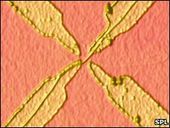
The microscope is under high vacuum and kept exceptionally cold.
The amount of electric charge on single atoms has been measured by researchers reporting in Science.
While individual atoms' charges have been measured before, the prior method required that the atoms be on the surface of a conducting material.
The new approach used a tiny tuning fork-like device that was deflected minuscule amounts by the attraction or repulsion of the atoms.
The approach will aid in the design of devices such as solar cells.
Gerhard Meyer of IBM's Zurich research laboratory first showed in 2004 that individual atoms' charge could be measured using a device known as a scanning tunnelling microscope (STM).
An STM has a tiny metallic tip - ending in one or a few atoms - which measures physical properties of microscopic-scale samples by passing a small current through them and measuring how this current varies across a sample.
However, an STM requires that the samples be at the surface of a conducting material, so that charges can move around or be lost entirely to this conducting substrate.
Good as goldThe new work hinges on the use of a research tool called an atomic force microscope, or AFM, which as its name implies can measure forces at the atomic level.

Molecular electronics, like this transistor, require atomic precision
An AFM employs a similar tiny tip, ending in just one atom. The tip is suspended from a cantilever - a beam just a few billionths of a metre across that acts like a diving board.
The researchers attach a small voltage to the diving board and set it vibrating near its natural resonant frequency.
When the tip comes close to a charged sample, the vibration's frequency changes slightly as the "opposite charges attract" principle gets to work on the single-atom level, changing the force acting on the tip and the cantilever.
The deviations of the cantilever are less than an atom's diameter, and the team can measure whether a gold or silver atom has a single extra electron or lack of one.
'The basics'It is an unthinkably precise measure; more than a billion billion electrons pass through a 60W light bulb every second.
Yet the fine details of the movement of individual charges are critically important, both for existing pursuits such as solar cells and for the nascent field of "molecular electronics", in which molecules act as circuit elements.
The charge transfer processes that ultimately determine a solar cell's efficiency will be easier to optimise knowing the exact movements of charge within materials.
"That is what makes this technique so important; it's not only the charge state of an atom but we want to go further and investigate molecules and measure distribution of charges," IBM's Leo Gross told the BBC.
The approach will also allow researchers to see at the most fundamental level how electric charge transfers in catalysts, or how charges get separated in molecular complexes such as some of the machinery of photosynthesis.
"We're not directly aiming at making a photovoltaic cell or a computer in our system," Dr Gross said. "We're trying to understand the basics of the processes in such devices."


Reader Comments
to our Newsletter